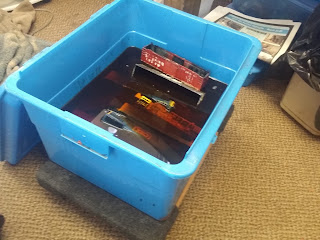Stripping paint from Model Trains and Locomotives 5 Methods
How to remove paint from models
There are several methods to remove paint from models. Each method has it's own risks and effectiveness.
I strip a lot of old locomotives and a few freight cars - here's how I do it:
Method 1 91% Rubbing Alcohol
I use a tub with a top, tupperware is good for this. Pour in as many bottles as it take to submerge the shell you want to strip. Highly effective on newer paints that are much thinner than the old school toy paint jobs...
Let soak for as long as you need to, sometimes days or weeks, but in the case of modern paint jobs it can be as short as an hour or 2.
I had a locomotive that was primered with gray auto primer in there for a few weeks. I noticed that the paint wasn't coming off, but it was bubbling a bit. I took it out and placed it in front of a fan and the fast drying action caused all the primer to flake off. That would be a rare case, but you never know unless you try it.
The rubbing alcohol method usually leaves the plastic intact with no damage, but I have has shells that developed striations, very rare though.
It must be 91% rubbing alcohol. Use this method first unless you know the paint really well and know it won't work.
Method 2: 8% (or higher) pine oil
Pinesol will NOT work for this, it doesn't actually contain real pine oil. Fortunately the bargain brands at Walmart say on the bottle that they contain about 8-9% pine oil and they are much cheaper.
I use a 5 gallon tote box to do this. This method can take weeks to work, but sometimes overnight will do the job.
I keep the oil, which is very heavy, in the tote and on top of a 4 wheel dolly. Even with the lid on, I put a large bath towel over the box to keep it from stinking up the place. This method works pretty good on toy type paint jobs, but takes quite a while. The make it work faster, clean the shell each day with dish soap and a stiff tooth brush and put it back in. I often put future projects in here and leave them for sometimes months until I'm ready to use them. I haven't noticed and plastic damage from this method.
Method 3: Brake Fluid
For really tough paint jobs, brake fluid soaking can often do the trick. There are shells that can be attacked by the brake fluid, but in general it works pretty good. I've soaked many shells for weeks in brake fluid and it will remove some of the toughest paint I've ever encountered. But, try method 1 and 2 before you resort to the brake fluid.
I double bag the shells and don't submerge the shells, I let the fluid spread through the bags. I place the bags in a tupperware container, but don't seal it up. Just roll the bags shut around the shell. Check within in the first hour, then everyday until you are comfortable with this. Works best on toy paint. Frequent cleanings help, but this method increases the risk of melting a shell.
Method 4: EZ strip
I got this stripper at Home Depot. There are many others that will melt the plastic, especially the citrus strippers. EZ strip will also melt the plastic so you have to actually sit down and do this one by hand a little at a time with a tooth brush. Frequently spray with a soap and water mix like 409 or spray and wipe and then wash in dish soap with a tooth brush. Many small applications will do the job. Don't turn your back on any section with this stuff applied or it will melt the plastic.
Many washings with dish soap in between small area applications of EZ strip. Very effective, but very high risk.
Method 5: Oven Cleaner
This is how we did it back the 1980's. I say don't use this method, I've melted shells many times doing this. But, if you must know how, then what you do is heat the oven to 100 and use a cookie sheet. Spray the shell with oven cleaner and put it in the oven for a couple mins at most, take it out, wash it and do it again. Takes off most paint, but melts plastic more than 50% of the time. You can do it without using the oven in a plastic bag, but that almost always leads to striations in you plastic.
Bottom line: don't use the oven cleaner method, too much risk.
There are also model products you can buy to remove paint, I don't use them, but I've seen that they are generally very good and effective.
So why go through the trouble of these other methods? Simple, they are much cheaper and the first 2 are just fire and forget methods - drop the shell in and come back when you're ready for it. Otherwise, you can buy the good stuff and do it right now.

























































